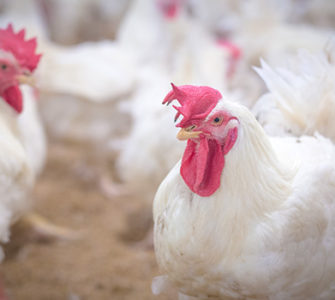IBDV: Management obstacles and options
By Daral J. Jackwood, PhD
Professor, Department of Veterinary Preventive Medicine
Food Animal Health Research Program
Ohio Agricultural Research and Development Center
The Ohio State University
For most broiler flocks, controlling infectious bursal disease virus (IBDV) and resulting immunosuppression is best accomplished with a strong breeder-vaccination program. The maternal immunity passed on to chicks will usually help protect them until they are 3 to 4 weeks of age. However, it doesn’t always work out that way. Flocks infected before 2 weeks of age can still suffer permanent immune suppression despite maternal immunity.
When IBDV infection in broiler flocks occurs after 3 to 4 weeks of age — when maternal immunity has waned — it can result in reduced feed efficiency, slowed growth rate and uneven flocks. It might also lead to temporary immune suppression as well as a greater risk for costly secondary infections, which often become more critical in antibiotic-free and reduced-use programs.
To help prevent the damaging effects of IBDV, producers need to simulate active immunity in their flocks. Live, attenuated vaccines have been used successfully in layers and can also help mitigate IBD in broilers, but maternal immunity levels can vary between flocks and even among individuals within a flock, which makes proper timing of field application somewhat problematic.
To avoid these issues, many producers have turned to recombinant herpesvirus of turkey (HVT) IBDV or to immune-complex (IC) vaccines. Both can be administered in ovo or on day 1 of age at the hatchery.
HVT-IBDV vaccines
The value of HVT-IBDV vaccines has been demonstrated in numerous studies.1,2 These vaccines have been shown to induce protection against multiple IBDV strains3,4 with no risk of bursa damage. However, in some cases, protective immunity to IBDV in broilers has been slow to develop.5 Field observations indicate that some producers see an initial protective response followed by reduced efficacy in subsequent vaccinated flocks.
Combining recombinant HVT-IBDV vaccines with other recombinant HVT vaccines for Newcastle disease or infectious laryngotracheitis is not recommended because viral interference can occur between the HVT viruses. Consequently, if an HVT recombinant vaccine is needed for managing either respiratory disease, an alternative to the HVT-IBDV vaccine is needed.
IC vaccines
The IC vaccines in general contain a mixture of modified-live vaccine virus and anti-IBDV antibody. The antibodies in these products are bound to the IBDV vaccine virus. These antibodies greatly reduce the ability of the vaccine virus to replicate early in the broiler’s life. As a result, damage to the bursa and immune suppression are minimal and often undetected.6,7 Thus, the IC-IBDV vaccines are safe alternatives to HVT-IBDV vaccines.
IC vaccines have been developed for a variety of viral as well as bacterial pathogens.8 The antibody-antigen complex has been shown to enhance humoral and cellular immunity by targeting the vaccine antigens directly to Fc receptors on antigen-processing cells.9 Fc receptors are proteins that help the immune system provide protection.
Vaccinating with an IC-IBDV vaccine in the presence of maternal antibodies to IBDV seems counterintuitive. However, these vaccines have been demonstrated to stimulate active immunity to IBDV, even when maternal antibody titers are relatively high.7
The IC-IBDV vaccines may produce some cross-protection among antigenically diverse IBDV strains, but, like the HVT-IBDV vaccines, the protection they help induce in broilers is expected to be greater against IBDV strains that are similar (homologous) and not antigenically diverse.
Summary
When maternal immunity and the protection it provides against IBDV-induced immune suppression is not enough, HVT-IBDV and IC-IBDV vaccines have been used successfully. Furthermore, they can be administered in ovo, they are safe and some may cross-protect against antigenically diverse IBDV.
No vaccine is perfect, but these are excellent choices for inducing active immunity to IBDV in the presence of IBDV maternal antibodies as well as for extending protection against IBDV-induced immune suppression in broilers.
Editor’s note: The opinions and advice presented in this article belong to the author and, as such, are presented here as points of view, not specific recommendations by Poultry Health Today.
1. Bublot M, et al. Use of a Vectored Vaccine against Infectious Bursal Disease of Chickens in the Face of High-Titered Maternally Derived Antibody. J Comp Pathol. 2007;137:S81-S84.
2. Le-Gros FX, et al. Field efficacy trial of a novel HVT-IBD vector vaccine for 1-day-old broilers. Vaccine. 2009;27:592-596.
3. Tsukamoto K, et al. Protection of chickens against very virulent infectious bursal disease virus (IBDV) and Marek’s disease virus (MDV) with a recombinant MDV expressing IBDV VP2. Virol. 1999;257:352-362.
4. Perozo F, et al. Efficacy of single dose recombinant herpesvirus of turkey infectious bursal disease virus (IBDV) vaccination against a variant IBDV strain. Avian Dis. 2009 Dec;53(4):624-628.
5. Gelb J, et al. Efficacy of recombinant HVT-IBD vaccines administered to broiler chicks from a single breeder flock at 30 and 60 weeks of age. Avian Dis. 2016 Sept;60(3):603-612.
6. Hassanzadeh M, et al. Evaluation of the immunogenisity of immune complex infectious bursal disease vaccine delivered in ovo to embryonated eggs or subcutaneously to day-old chicks. Int J Poult Sci. 2006;5:70-74.
7. Haddad E, et al. Efficacy of a novel infectious bursal disease virus immune complex vaccine in broiler chickens. Avian Dis. 1997;41:882-889.
8. Hioe C, et al. The use of immune complex vaccines to enhance antibody responses against neutralizing epitopes on HIV-1 envelope gp120. Vaccine. 2009;28:352-360.
9. Pham G, et al. Fc receptor-targeting of immunogen as a strategy for enhanced antigen loading, vaccination, and protection using intranasally administered antigen-pulsed dendritic cells. Vaccine. 2014;32:5212-5220.
Posted on April 26, 2017

















